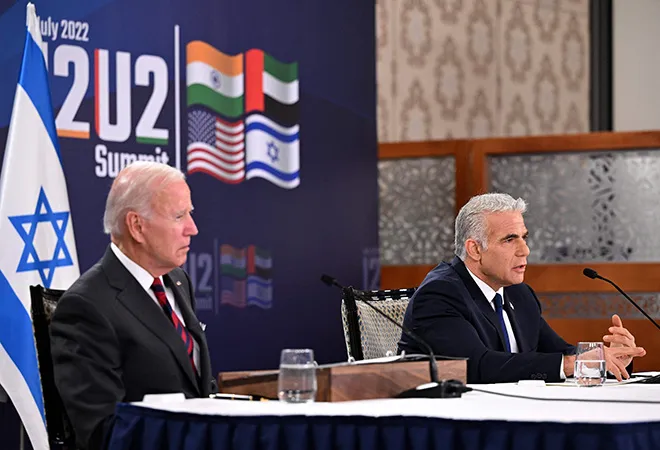Despite Israel’s robust and advanced defence system, it was caught off guard by a well-coordinated attack from Hamas on 7 October 2023. The Hamas attack on Israel exposed a loophole in Israeli intelligence and led to a complete system breakdown. The attackers used unconventional methods, catching the highly advanced Israeli military by surprise. Despite Gaza’s border having ground-based sensors, cameras, thermal imaging devices, and regular patrols backed by quick-reaction teams, these measures failed.
Similar instances, such as the Houthis using drones against Saudi Air Defence in 2021, Hezbollah deploying technology in Syria, and Turkish-backed rebels executing a “swarming attack” on Russian bases in Syria, or the Azerbaijan-Armenia Conflict 2023, highlight evolving tactics in conflict zones. These recent conflicts indicate that nations must be prepared to face new risks that enable weaker and even primitive military forces to create threats that never existed before. Approximately 65 terrorist groups currently employ Uncrewed Aerial Systems (UAS), like ISIL, the Taliban, Hamas, and Syrian rebel groups, to name a few, presenting a formidable challenge to the security and defence of democratic nations.
The Hamas attack on Israel exposed a loophole in Israeli intelligence and led to a complete system breakdown.
This article aims to emphasize on the need for adaptive counter-terrorism strategies, global collaboration, and the recognition of Artificial Intelligence’s (AI) dual-use nature to navigate the complex intersection of technology and terrorism effectively. Terrorists are increasingly engaging in cyber warfare, presenting substantial threats to national security and critical infrastructure. Thus counter-terrorism efforts face the challenge of navigating this intricate landscape, necessitating a clear understanding of the dynamic interplay of technology and terror and developing strategies to thwart them.
Pitfalls in counter-terrorism strategies
The omnipresence of technology, manifesting in diverse forms, poses a formidable challenge for governments contending with the persistent spectre of terrorism. Firstly, the inadequate acknowledgement of the dynamic nature and magnitude of the technological threat complicates security planning. The potential for terrorist attacks through innovative technological means remains unattended. A myopic focus on mitigating known vulnerabilities may inadvertently expose nations to new forms of hostility.
Secondly, the swift evolution of technology often outpaces the development of regulatory frameworks, thereby hindering the formulation of effective defensive strategies. Striking a balance between leveraging technology for its positive contributions and curtailing its misuse is a complex task, necessitating the granting of robust powers to law enforcement and the establishment of partnerships between the government and private enterprises.
The utilisation of technology by terrorist organisations mandates that governments reassess their strategies to mitigate emerging threats effectively.
Moreover, the fast progression of technological advancements and the simultaneous obsolescence of counter-strategies contribute to limited effectiveness. Lastly, a potential pitfall arises from “technology fatigue,” as underscored in the Berlin Memorandum (2019). The recurrent incidence of minor terrorism events at times fosters complacency among authorities. The utilisation of technology by terrorist organisations mandates that governments reassess their strategies to mitigate emerging threats effectively.
Current landscape: Global actions against technological exploitation in counterterrorism
In examining the global landscape, it is evident that numerous efforts are made by international and national bodies. Nations have taken significant steps to counter terrorist organisations’ use of technology. To enhance counter-terrorism efforts, countries can employ new strategies to secure their national interests:
- Employing AI—Recognising AI’s dual-use nature is critical to navigating its future impact on security. Leveraging AI applications for border protection, akin to the European Union’s (EU) ETIAS (European Travel Information Authorisation) System, offers a practical avenue for securing porous borders such as the Line of Actual Control, the Indo-Nepal border, or the Indo-Bangladesh border. Similarly integrating predictive analytics and AI models to analyse online behaviour is a promising approach to predicting terrorist activities. Successful AI-driven counter-terrorism strategies, like those in EU-funded projects RED-Alert and Moonshot, hinge on collaborative efforts with civil societies.
- Adapting from the security models of global bilateral partners—Insights from global partners, such as NATO’s DEXTER (Detection of Explosives and Firearms to Counter Terrorism) and the United Arab Emirates’ (UAE) measures for unauthorised aircraft in the airspace, provide valuable lessons. These two models offer adaptable and practical models to address specific threats effectively.
- United Nations Terrorist Travel Programme: Countries globally are actively implementing strategic measures to counter the growing threat of technology use by terror groups. One pivotal initiative is the United Nations Terrorist Travel Programme (UN TTP), introduced in 2019 by the United Nations Office of Counter Terrorism (UNOCT). This programme focuses on assisting member states in meeting Security Council resolutions, particularly in the detection of Foreign Terrorist Fighters (FTFs).
- National Cybersecurity Strategy: Recognising threats to national assets like nuclear facilities, healthcare, and energy infrastructure, several nations, including the United Kingdom (UK) and various European Union countries, have established dedicated National Cybersecurity Agencies (NCAs). Moreover, models such as the European Union’s Network and Information Security (NIS) provide frameworks for designing country-specific programmes based on meticulous threat assessments.
Moving ahead
Countries vary in their approaches to combat technology-based terrorism. However, certain existing strategies need attention to formulate an effective approach.
- Establishing regulatory governance: Addressing the tension between regulatory and enforcement entities by establishing sector-specific regulations to ensure compliance.
- Diversify threat intelligence sources: Apart from traditional channels, establish platforms for quick and confidential sharing of threat intelligence between the government and private sector.
- Develop a strong mobilisation plan: Create a comprehensive plan outlining which government entities should respond to cyber incidents and their specific roles, aligning with a severity-assessment matrix.
- Collaborate with educational institutions: Certify cybersecurity courses in partnership with universities to ensure high-quality education and skill development.
- Centralise training resources: Establish a central training portal, similar to the US Federal Virtual Training Environment, offering free online cybersecurity training to government employees and contractors.
- Engage private-sector training providers: Provide incentives to attract global private-sector training companies to set up centres and offer courses.
- Regional approaches: Conduct field research to understand the technological capabilities of terror networks, tailor solutions to address regional challenges, and foster collaboration for an effective response. Consider multicultural and multilingual aspects unique to South Asia when developing apps for counter-terrorism measures using technology and AI.
In conclusion, government agencies play a crucial role in establishing a comprehensive framework for preventing and managing technology-related terrorism. This involves creating a legal, institutional, and collaborative environment that harnesses technology as a tool to safeguard nations. To achieve these objectives, governments must engage various stakeholders within the ecosystems.
______________________________________________________________________________________________________________________________
Soumya Awasthi is a freelance consultant.












